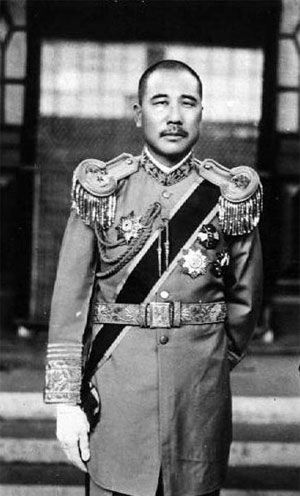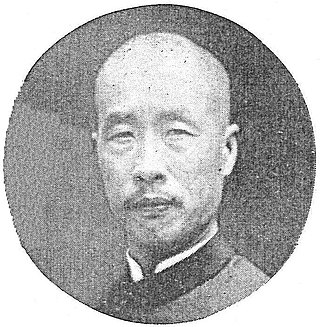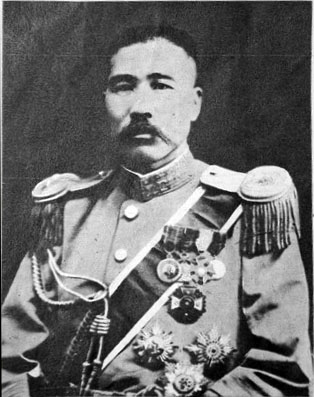
The Northern Expedition was a military campaign launched by the National Revolutionary Army (NRA) of the Kuomintang (KMT) against the Beiyang government and other regional warlords in 1926. The purpose of the campaign was to reunify China, which had become fragmented in the aftermath of the Revolution of 1911. The expedition was led by Generalissimo Chiang Kai-shek, and was divided into two phases. The first phase ended in a 1927 political split between two factions of the KMT: the right-leaning Nanjing faction, led by Chiang, and the left-leaning faction in Wuhan, led by Wang Jingwei. The split was partially motivated by Chiang's Shanghai Massacre of Communists within the KMT, which marked the end of the First United Front. In an effort to mend this schism, Chiang Kai-shek stepped down as the commander of the NRA in August 1927, and went into exile in Japan.

Feng Yuxiang, courtesy name Huanzhang (焕章), was a Chinese warlord and a leader of the Republic of China from Chaohu, Anhui. He served as Vice Premier of the Republic of China from 1928 to 1930. He was also known as the "Christian General" for his zeal to convert his troops and the "Traitorous General" for his penchant to break with the establishment. In 1911 he was an officer in the ranks of Yuan Shikai's Beiyang Army but joined forces with revolutionaries against the Qing dynasty. He rose to high rank within Wu Peifu's Zhili warlord faction but launched the Beijing Coup in 1924 that knocked Zhili out of power and brought Sun Yat-sen to Beijing. He joined the Nationalist Party (KMT), supported the Northern Expedition and became blood brothers with Chiang Kai-shek, but resisted Chiang's consolidation of power in the Central Plains War and broke with him again in resisting Japanese incursions in 1933. He spent his later years supporting the Revolutionary Committee of the Kuomintang.

Zhang Zuolin was a Chinese warlord who ruled Manchuria from 1916 to 1928. He led the Fengtian clique, one of the most important factions during China's Warlord Era. During the last year of his life, he briefly installed himself as President of the Republic of China.

The Jinan incident or 3 May Tragedy began as a 3 May 1928 dispute between Chiang Kai-shek's National Revolutionary Army (NRA) and Japanese soldiers and civilians in Jinan, the capital of Shandong province in China, which then escalated into an armed conflict between the NRA and the Imperial Japanese Army.

The Nanking Incident occurred in March 1927 during the capture of Nanjing by the National Revolutionary Army (NRA) in their Northern Expedition. Foreign warships bombarded the city to defend foreign residents against rioting and looting. Several ships were involved in the engagement, including vessels of the Royal Navy and the United States Navy. Marines and sailors were also landed for rescue operations including some 140 Dutch forces. Both Nationalist and Communist soldiers within the NRA participated in the rioting and looting of foreign-owned property in Nanjing.

Zhang Zongchang, courtesy name Xiaokun, was a Chinese warlord who ruled Shandong from 1925 to 1928. A member of the Fengtian clique, Zhang was notorious for his brutal and ruthless behavior, eccentric personality, and extravagant lifestyle, which earned him nicknames such as the "Dogmeat General"; Time dubbed him China's "basest warlord". Zhang's troops were defeated by the National Revolutionary Army during the Northern Expedition in 1928, and he fled to Japan before returning to Shandong in 1932, where he was assassinated by a young officer.

The Warlord Era was a period in the history of the Republic of China when control of the country was divided among former military cliques of the Beiyang Army and other regional factions from 1916 to 1928.

The Northeastern Army, also known as the Fengtian Army, was a Chinese army that existed from 1911 to 1937. It was created by General Zhang Zuolin and his "Fengtian Clique", who controlled Northeastern China (Manchuria) during China's Warlord Era. The Northeastern Army participated in many of the Warlord Era's conflicts and by the mid-1920s had become the dominant force in north China. However, the Kuomintang defeated the Northeastern Army and Zhang's allies during the Northern Expedition. In 1928, Zhang Zuolin was assassinated and succeeded by his son Zhang Xueliang. Xueliang pledged loyalty to the Kuomintang, bringing almost all of China under the same national government for the first time since 1917.

Sun Dianying was a Chinese bandit leader, warlord, and National Revolutionary Army commander who fought in the Warlord Era, Second Sino-Japanese War, and Chinese Civil War, earning notoriety for changing sides multiple times in course of these conflicts.
The Second Zhili–Fengtian War of 1924 was a conflict between the Japanese-backed Fengtian clique based in Manchuria, and the more liberal Zhili clique controlling Beijing and backed by Anglo-American business interests. The war is considered the most significant in China's Warlord era, with the Beijing coup by Christian warlord Feng Yuxiang leading to the overall defeat of the Zhili clique. During the war the two cliques fought one large battle near Tianjin in October 1924, as well as a number of smaller skirmishes and sieges. Afterwards, both Feng and Zhang Zuolin, the latter being ruler of the Fengtian clique, appointed Duan Qirui as a figurehead prime minister. In south and central China, more liberal Chinese were dismayed by the Fengtian's advance and by the resulting power vacuum. A wave of protests followed. The war also distracted the northern warlords from the Soviet-backed Nationalists based in the southern province of Guangdong, allowing unhampered preparation for the Northern Expedition (1926–1928), which united China under the leadership of Chiang Kai-shek.

The Central Plains War was a series of military campaigns in 1929 and 1930 that constituted a Chinese civil war between the Nationalist Kuomintang government in Nanjing led by Generalissimo Chiang Kai-shek and several regional military commanders and warlords who were former allies of Chiang.

Han Fuju or Han Fu-chü was a Kuomintang general in the early 20th century. He rose up the ranks of the Guominjun clique in the Warlord era but then went over to the Kuomintang, and held the position of military governor of Shandong from 1930 to 1938. Han had one wife, two concubines, and four sons.

Shi Yousan was a Chinese general of the National Revolutionary Army who served as the 9th Governor of the Chahar and 3rd Governor of Anhui provinces during the Republican era of China.

The Warlord Rebellion in northeastern Shandong was an uprising of several allied Chinese warlord armies under the leadership of Zhang Zongchang in 1929. The rebels wanted to regain their former territories in Shandong from Liu Zhennian, the man who had defected from Zhang to the Nationalist government in Nanjing during the Northern Expedition. After some initial successes, the rebels were defeated due to the indiscipline of their forces. In the end, the uprising failed to topple Liu Zhennian's rule over eastern Shandong, but resulted in high civilian casualties and widespread destruction at the hands of both sides in the conflict.

The Han–Liu War was a major military conflict in late 1932 between the private armies of Han Fuju and Liu Zhennian over Shandong. Even though Han as well as Liu were officially subordinates to the Chinese Nationalist government in Nanjing, both were effectively warlords with their own autonomous territories. Han Fuju controlled most of Shandong and had long desired to also capture the eastern part of the province, which was held by Liu. The tensions between the two eventually escalated, leading to a war that saw Han emerge victorious. He went on to rule Shandong unopposed for the next six years, while Liu was exiled to southern China.
The Fengtian clique's Zhili Army was a Chinese Warlord Era fighting force that controlled the Republic of China's Zhili province from 1924 until 1928, with the exception of a few months in 1925/26. Not related to the Zhili clique, it instead originated as Fengtian Second Army and operated as part of the Fengtian clique's armed forces. It was led by two successive Fengtian warlords, Li Jinglin and Chu Yupu, who always followed the orders of Zhang Zuolin, the Fengtian clique's overall leader. Although the Zhili Army's quality declined after 1925, it distinguished itself in numerous battles until it was disbanded in 1928 after being defeated by the National Revolutionary Army in the Northern Expedition.
The Red Spear Society staged a major uprising in 1928–1929 against the rule of Liu Zhennian, the Nationalist government-aligned warlord ruler of eastern Shandong province in Republican China. Motivated by their resistance against high taxes, rampant banditry and the brutality of Liu's private army, the Red Spear peasant insurgents captured large areas on the Shandong Peninsula and were able to set up a proto-state in Dengzhou county. Despite this, the whole insurgency was eventually crushed by Liu in late 1929.

Konstantin Petrovich Nechaev was an Imperial Russian Army officer and White movement leader, who commanded a large Russian mercenary army in China from 1924 to 1929. Fighting for the Fengtian clique warlords Zhang Zuolin and Zhang Zongchang, Nechaev took part in several wars of the Chinese Warlord Era until his mercenary force was destroyed in the Northern Expedition. Thereafter, he mostly retired from military service and became a White émigré community leader in Manchuria. Captured by SMERSH during the Soviet invasion of Manchuria, Nechaev was executed by Soviet authorities in 1946.

The Wuhan Nationalist government, also known as the Wuhan government, Wuhan regime, or Hankow government, was a government dominated by the left-wing of the Nationalist or Kuomintang (KMT) Party of China that was based in Wuhan from 5 December 1926 to 21 September 1927, led first by Eugene Chen, and later by Wang Jingwei.

The National Pacification Army (NPA), also known as the Anguojun or Ankuochun, was a warlord coalition led by Fengtian clique General Zhang Zuolin, and was the military arm of the Beiyang government of the Republic of China during its existence.


















